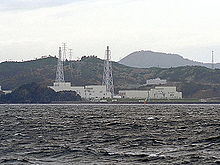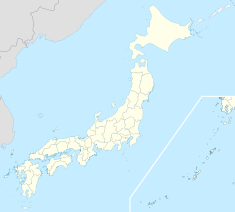- Onagawa Nuclear Power Plant
-
Onagawa Nuclear Power Plant 
The Onagawa Nuclear Power PlantLocation of Onagawa Nuclear Power Plant Country Japan Coordinates 38°24′04″N 141°29′59″E / 38.40111°N 141.49972°ECoordinates: 38°24′04″N 141°29′59″E / 38.40111°N 141.49972°E Construction began July 8, 1980 Commission date June 1, 1984 Operator(s) Tohoku Electric Power Company Reactor information Reactors operational 1 x 524 MW
2 x 825 MWPower generation information Annual generation 5,283 GW·h Net generation 157,545 GW·h Website
Japanese version, English versionAs of July 25, 2007 The Onagawa Nuclear Power Plant (女川原子力発電所 Onagawa (
 pronunciation) genshiryoku hatsudensho, Onagawa NPP) is a nuclear power plant located on a 1,730,000 m2 (432 acres) site[1] in Onagawa in the Oshika District and Ishinomaki city, Miyagi Prefecture, Japan. It is managed by the Tohoku Electric Power Company. It was the most quickly constructed nuclear power plant in the world.[citation needed]
pronunciation) genshiryoku hatsudensho, Onagawa NPP) is a nuclear power plant located on a 1,730,000 m2 (432 acres) site[1] in Onagawa in the Oshika District and Ishinomaki city, Miyagi Prefecture, Japan. It is managed by the Tohoku Electric Power Company. It was the most quickly constructed nuclear power plant in the world.[citation needed]The Onagawa-3 unit was used as a prototype for the Higashidori Nuclear Power Plant.[citation needed]
The plant conforms fully to ISO 14001, a set of international environmental management standards. The plant's waste heat water leaves 7 degrees Celsius higher than it came in and is released 10 meters under the surface of the water, in order to reduce adverse effects on the environment[2] All the reactors were constructed by Toshiba.[3]
Contents
Reactors on Site
Unit Type Start of Operation Electric Power Onagawa - 1 BWR June 1, 1984 524 MW Onagawa - 2 BWR July 28, 1995 825 MW Onagawa - 3 BWR January 30, 2002 825 MW Unit 1
Shut down manually on 25 February 2005 because it was determined that the reactor containment leaked small amounts of nitrogen. The unit was restarted once Nuclear and Industrial Safety Agency was satisfied that the countermeasures taken by the plant operator to prevent a reoccurrence were adequate.[4]
Unit 2
- May 2006 it was confirmed that a pipe was leaking due to debris damage.
- June 7, 2006 Difficulties with pressure control prompted further inspections.
- July 7, 2006 METI and the Nuclear and Industrial Safety Agency determined that the plant's performance was not satisfactory.[citation needed]
Unit 3
- July 7, 2006 Due to pipe integrity concerns the reactor was shut down.
- November 25, 2006 Following repairs the reactor was restarted.
- March 11, 2011 2011 Tōhoku earthquake damaged the turbines after a fire broke out and was shut down.
Incidents
2001
Small fire in the administrative offices. Did not affect functioning of the plant.
2005
The Onagawa Nuclear Power Plant was affected by the 2005 Miyagi earthquake and recorded vibrations above what the plant was designed for. Analysis after the event, however, found no damage to the reactor systems. Some people reported seeing smoke come from the plant after the earthquake and reported it, thinking that it indicated an accident, but the smoke was actually produced by the backup diesel generators.[citation needed]
2011
On April 8, 2011, a leak of radioactive water spilled from pools holding spent nuclear fuel rods following the 2011 Tōhoku earthquake , the nuclear safety agency said, was reported by Kyodo News [1]
A fire from the turbine section of the plant following the 2011 Tōhoku earthquake was reported by Kyodo News.[5]
On March 13, 2011, levels of radiation on site reached 21μSv/hour, a level at which Tohoku Electric Power Company were mandated to declare state of emergency, and they did so at 12:50, declaring the lowest-level such state. Within 10 minutes the level had dropped to 10μSv/hour.[6][7][8] The Japanese authorities assume the temporarily heightened values were due to radiation from the Fukushima I nuclear accidents and not from the plant itself.[9][10] On March 13 20:45 UTC, the IAEA announced that radiation levels at the Onagawa plant had returned to normal background levels.[9]
The three units remain in cold shutdown since the earthquake of 11 March. Two hundred people who lost their homes to the tsunami took refuge in the plant.[11] The April 7th aftershock damaged 2 of the 3 external power lines to the plant but cooling was maintained through the third line.[12]
See also
- 2011 Japanese nuclear accidents
- List of boiling water reactors
- Lists of nuclear disasters and radioactive incidents
References
- ^ Tohoku Power. The Onagawa Plant (information).
- ^ Tohoku Power. Onagawa Nuclear Power Station.
- ^ Toshiba. Nuclear List of Delivered Units.
- ^ http://www2.jnes.go.jp/atom-db/en/trouble/individ/power/e/e20050225/index.html Manual Shutdown of Onagawa NPP Unit-1
- ^ "Fire at Tohoku Elec Onagawa nuclear plant". Kyodo | Reuters. Reuters. 2011. http://www.reuters.com/article/2011/03/11/quake-japan-nuclear-idUSLHE7E801E20110311. Retrieved March 13, 2011.
- ^ "Contamination checks on evacuated residents". world-nuclear-news.org. 2011. http://www.world-nuclear-news.org/RS-Contamination_found_on_evacuated_residents-1303114.html. Retrieved March 13, 2011. "A technical emergency was declared at 12.50 pm today at the Onagawa nuclear power plant after radiation levels in the plant site reached 21 microSieverts per hour. At this level plant, owner Tohoku Electric Power Company is legally obligated to inform government of the fact. Within just ten minutes, however, the level had dropped to 10 microSieverts per hour."
- ^ "IAEA update on Japan Earthquake". iaea.org. March 13, 2011. http://www.iaea.org/newscenter/news/tsunamiupdate01.html. Retrieved March 13, 2011. "Japanese authorities have also informed the IAEA that the first (i.e., lowest) state of emergency at the Onagawa nuclear power plant has been reported by Tohoku Electric Power Company. The authorities have informed the IAEA that the three reactor units at the Onagawa nuclear power plant are under control. As defined in Article 10 of Japan's Act on Special Measures Concerning Nuclear Emergency Preparedness, the alert was declared as a consequence of radioactivity readings exceeding allowed levels in the area surrounding the plant. Japanese authorities are investigating the source of radiation."
- ^ Chico Harlan, Steven Mufson: Japanese nuclear plants' operator scrambles to avert meltdowns. The Washington Post, March 11, 2011
- ^ a b "Fukushima Nuclear Accident Update Log - Updates of 13 March 2011". iaea.org. 2011. http://www.iaea.org/newscenter/news/2011/fukushima130311.html. Retrieved March 13, 2011.
- ^ "Sea water injected into troubled Fukushima power plant | The Manila Bulletin Newspaper Online". mb.com.ph. 2011 [last update]. http://www.mb.com.ph/articles/309172/sea-water-injected-troubled-fukushima-power-plant. Retrieved March 13, 2011. "Meanwhile, radiation monitored at the Onagawa nuclear power plant in Miyagi Prefecture on the Pacific coast shot up on Sunday, Tohoku Electric Power Co. said, adding that it was likely caused by radioactive substances let out at the troubled Fukushima No. 1 nuclear power plant in Fukushima Prefecture."
- ^ Ito, Shingo (Agence France-Presse/Jiji Press), "Neighbors of Miyagi reactor mull getting out", Japan Times, 1 April 2011, p. 3.
- ^ Japan earthquake today: Tsunami warning lifted, but Fukushima evacuated, Christian Science Monitor, Gavin Blair, April 7, 2011
External links
Nuclear power in Japan Active LWR plants Fukushima Daiichi · Fukushima Daini · Genkai · Hamaoka · Higashidōri · Ikata · Kashiwazaki-Kariwa · Mihama · Ōi · Onagawa · Sendai · Shika · Shimane · Takahama · Tokai · Tomari · TsurugaOther plants Kaminoseki · Maki · Monju · Namie-Odaka · Ōma · Fugen (ATR) (inactive) · Jōyō (FBR) · Rokkasho (reprocessing)Fukushima Daiichi nuclear disaster Cleanup · Timeline · Radiation effects · Japanese reaction · International reaction · Reactor units 4, 5 and 6Companies Chugoku Electric Power Company · Japan Nuclear Fuel Limited · Mitsubishi FBR Systems · Tokyo Electric Power CompanyOrganisations Atomic Energy Commission · Japan Atomic Energy Agency · Japan Electric Association · Nuclear Safety Commission · Nuclear and Industrial Safety AgencyAnti-nuclear movement Anti-nuclear protests · Citizen's Nuclear Information Center · Tetsunari Iida · Haruki Murakami · Kenzaburo Oe · Ryuichi SakamotoMiscellaneous 2011 Japanese nuclear accidents · Iwaishima · Japanese nuclear incidents · Radiation Monitoring · Genpatsu-shinsai2011 Tōhoku earthquake and tsunami Aftermath • Humanitarian response · Foreshocks and aftershocksAffected areas Geology: Japan Trench • Pacific Plate • North American Plate • Okhotsk Plate • Honshu Island (Oshika Peninsula) / Pacific Ocean
Cities and towns severely damaged:- Tōhoku Region [Iwate Prefecture (Kamaishi – Miyako – Ōfunato – Ōtsuchi – Rikuzentakata – Yamada) | Miyagi Prefecture (Higashimatsushima – Ishinomaki – Kesennuma – Kurihara – Minamisanriku – Sendai) | Fukushima Prefecture (Iwaki – Minamisōma – Ōkuma – Sōma)]
- Kantō Region [Ibaraki Prefecture (Hitachinaka – Itako – Kashima – Kitaibaraki – Ōarai) | Chiba Prefecture (Asahi – Chōshi – Ichihara – Urayasu)]
- Hokkaido [Oshima Subprefecture (Hakodate)]
Affected infrastructure Ichihara refinery • Fujinuma Dam • Ōarai-Kashima Line • Sendai Airport • Tōhoku Shinkansen • Joban Line (Shinchi Station) • Senseki Line • Kesennuma LineNuclear accidents Fukushima Daiichi nuclear disaster (Fukushima Daiichi Nuclear Power Plant • Timeline • International reaction • Japanese reaction • Radiation effects • Fukushima 50) • Fukushima Daini Nuclear Power Plant (Timeline) • Onagawa plant • Tōkai plant • Rokkasho plantAftershocks Miyagi, Japan (7.1, 7 April) • Fukushima, Japan (6.6, 11 April)People Fundraisers Artistes 311 Love Beyond Borders • Download to Donate: Tsunami Relief • Fight and Smile • Songs for JapanOther Impact on video game industry • Operation TomodachiSee also: Japanese earthquakes · Seismicity of the Sanriku coast · Historic tsunamis ·
Japanese earthquakes · Seismicity of the Sanriku coast · Historic tsunamis ·  Nuclear power in Japan, section Seismicity · Nuclear and radioactive incidentsCategories:
Nuclear power in Japan, section Seismicity · Nuclear and radioactive incidentsCategories:- 1980s establishments in Japan
- 2011 Japanese nuclear incidents and accidents
- Miyagi Prefecture
- Nuclear power stations in Japan
Wikimedia Foundation. 2010.

